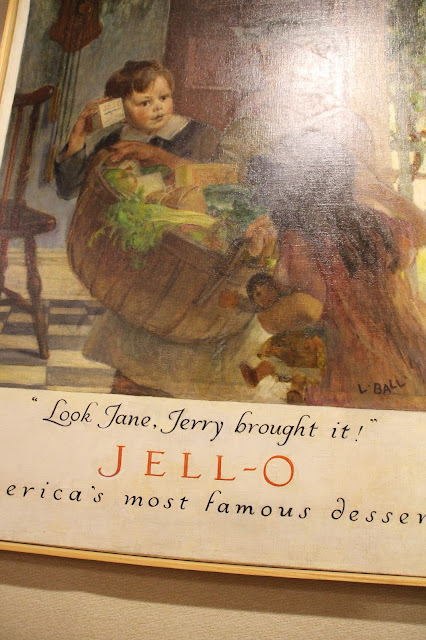July 2016 - LeRoy NY
This was an unplanned stop in LeRoy as we were driving to Buffalo. I was flipping through a tour pamphlet and thought this would be amusing.
A plaque to honour Jell-O employees who lost their lives in World War II.
We found the museum on Main St. and were meet on the porch by a funny little old lady who regaled us with
She then asked us if we wanted to meet an old lady who knew everything about Jell-O, to step inside and she was the guide for the museum. She was funny and witty and kept the group totally entertained.
This is a somewhat drier version of the story. And it's not just a story of the invention of Jell-O it is also the story of marketing ideas.
In 1845, the already famous inventor of the first American-built steam locomotive – the Tom Thumb – Peter Cooper, devised a way to make gelatin more accessible by making large sheets of it and grinding it into a powder. He applied for and was granted a patent (US Patent 4084) for a gelatin dessert powder he called “Portable Gelatin” requiring only the addition of hot water. Despite the future economic windfall a gelatin powder would provide, Cooper didn’t market it nor did much of anything with his invention. He sold the powder to cooks on occasion, but never commercialized it beyond that.
It has many other names around the world.
About thirty miles outside of Rochester, New York, in the small town of Leroy, lived the married couple of Pearl and May Wait. They ran a rather unsuccessful cough syrup and laxative business. After years of this and barely scraping by, they decided one day to branch out into something that they knew better, food. May cooked all the time and loved to make desserts. So, according to the Chemical Heritage Foundation, after looking around for what to work on, they found and obtained the patent for powdered gelatin.
Of course, the main drawback of gelatin is its lack of taste. They found a fix for that by combining it with something else they knew a fair bit about- making syrups. Thus, they added a significant amount of sugary fruit syrups, using strawberry, raspberry, lemon, and orange for flavoring. Their product was now 88 percent sugar, but none of that mattered because now gelatin actually tasted good!
May named her and her husband’s new favorite dessert “Jell-O,” a combined version of the words gelatin and jelly (with both words deriving from the Latin “gelare” meaning “to congeal” or “to freeze”). As for the “O” part, around this time in America it was simply a relatively popular trend to add “O” to the end of your product name. According to The Dictionary of Trade Names Origins, the practice got started simply because “O” is pleasing to the eye. In addition, it allows a business to take a common word and easily modify it to make it easy to trademark, another example of which from that era was “Grain-O.”
On September 8, 1899, the couple sold the formula, patent, and the name Jell-O to their Leroy neighbor, Orator Frank Woodward, owner of the Genesee Food Company, for $450 (about $12,000 today).
Already a successful packaged food businessman, Woodward knew how to sell a product. He dressed his salesmen in fancy suits and had them offer free samples to homemakers. They employed every trick in the book to get grocers to stock their shelves with boxes of Jell-O, still in the Waits’ original flavors, strawberry, raspberry, lemon, and orange. Despite all of this, sales still sagged. At one point, a frustrated Woodward offered to sell the product line to another Leroy townsmen for a mere $35. Luckily, for him, that person refused the offer.
In 1904, everything changed. With the help of the newly hired William E. Humelbaugh, Woodward decided to take some of the money he earned from the more successful products he made, including one that held a “miraculous power to kill lice on hens,” and invest it into ads for Jell-O in the national syndicated Ladies Home Journal.
The museum owns several original paintings.
Like The Saturday Evening Post, Jell-O has been around for eons, and this adorable ad by Norman Rockwell is from 1924. A master at depicting boys, Rockwell felt he wasn’t very good at painting little girls. I think we would all agree that this little girl is adorable.
Jell-O did use animals in their ads so it isn't really that strange.
Woodward began printing recipe books telling homemakers how to properly prepare their Jell-O. They handed out free Jell-O molds to immigrants arriving into Ellis Island. They introduced Jell-O girl, played by four year old Elizabeth King – the daughter of a brilliant ad artist, Franklin King, who Woodward had working for him. With a tea kettle in one hand and a packet of Jell-O in the other, she declared to the world that, “You can’t be a kid without it.”
My mother never got on the jell-O bandwagon making those dreadful molded recipes.
I can remember going to parties where these odious dishes were served. I never tried one!!!
Due to brilliant marketing, Jell-O became one of the most well-known brands in American history. In 1924, understanding the power of a name, the Genesee Pure Foods Company became, quite simply, the Jell-O Company. That same year, the company hired the soon-to-be-famous Norman Rockwell to draw colorful illustrations depicting Jell-O. He did just that, depicting a young girl serving a Jell-O to her doll at tea time.
With radio rising in prominence, Jell-O became one of the first companies to advertise on the new medium with Jack Benny singing to the whole world in 1934 their new jingle created by ad agency Young & Rubicam -“J-E-L-L-O.”
By the mid-1970s, formerly strong and steady sales of Jell-O (including their pudding line) began declining, so they hired the 37 year old comedian Bill Cosby to be their spokesperson. It worked and Cosby brought Jell-O to new heights. The Cosby/Jell-O relationship lasted for over thirty years and is considered, according Mary Cross’s book A Century of American Icons, the longest-standing celebrity endorsement in American advertising history.
In 1964, the plant in LeRoy, New York closed when the conglomerate General Foods (now Kraft Foods) took over production. But Jell-O is still represented in that small town with the Jell-O Gallery, a museum dedicated to all things Jell-O.
Of course you have to exit through the gift shop.
We were all given a box of Jell-O by the guide.
The museum is located next to the historic LeRoy House.
Next week I'll show you a surprise from the Jell-O museum.
Tuesday Travel

Our World Tuesday

Travel Photo Thursday

Weekend Travel Inspiration.
The Weekly Postcard

Weekend Wanderlust
Tuesday Travel

Our World Tuesday

Travel Photo Thursday

Weekend Travel Inspiration.
The Weekly Postcard

Weekend Wanderlust



































Great summary, Ruth(elderly woman who entertained us) would be proud.
ReplyDeleteWell how interesting...i was humming the J-E-L-L-O tune in my head as i was reading! i didn't know the jingle was that old!
ReplyDeleteI hope I didn't give you an earworm!
DeleteI have been by many times, but have never stopping in, must do something about this! There sure is a bunch of quirky, interesting stuff out there to discover. Thanks Jackie for sharing this week, I hope that you will return again soon.
ReplyDeleteTom, we should plan our next photo trip, starting here!
Deletewhenever I'm in LeRoy, it's way past closing time ;)
Jello has always seemed quirky to me.
So that's the history behind it! It's been years since I last had any.
ReplyDeleteWow, what a great find. Great photos.
ReplyDeleteI am somewhat frightened by some of those old Jell-O recipes. I do love Crown Jewel Dessert . Mom used to make it and now I do.
ReplyDelete:0)
I never did like those molded desserts either. In fact I have never liked Jell-o much. That is an interesting museum though and I think that cow with the town's history is fantastic.
ReplyDeleteLove hearing how things came about. Great tour!
ReplyDeleteEnjoyed your post with great Jello photos. Read this with a big smile. Jello popularity rose as home refrigeration became more common. Jello still has its place in the American diet.
ReplyDeleteI love weird and wonderful niche museums! I truly didn't know how much I didn't know about Jello!
ReplyDeleteThank you for sharing at http://image-in-ing.blogspot.com/2016/07/world-war-ii-memorial-washington-dc.html
ReplyDeleteWhat an interesting place to visit.
ReplyDeleteI never knew that Jello had such an interesting history behind it. I do remember the Bill Cosby commercials.
ReplyDeleteWell this was a neat post. I had no idea that was a museum for Jell-O. Don't you love an entertaining guide!!
ReplyDeleteLisa @ Life Thru the Lens